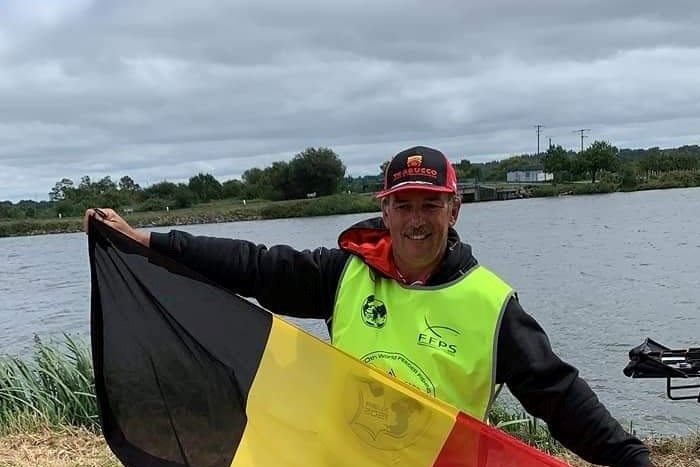Feeder fishing is a rapidly growing branch of fishing and is very popular in whitefishing. When fishing with a feeder, you always throw a basket full of food in the same spot. This creates temptation. Since you can throw very far with a pouring rod, some even up to a hundred meters, many places can be reached in the water. Thirteen meters is often the highest level that can be achieved with a fixed pole. It’s also nice for older anglers because they don’t have to hold their stick all the time.

World champions in forage hunting from Belgium. – © rr
Coach Walter Wiens brings five fishermen and a reserve to the World Championships on the La Vilain River in Rio, France. KVL (Royal United Line Fishermen) of Niel was the “lead supplier” with members Carl Franssen of Niel, Wesley Wuyts of Schelle and Benny Mertens of Schelle. Englers Bert de Mulder of Zottegem, Frank van Valderen of Turnhout and Chris Hebrechts of Bonheden, as the reserve completed the Belgium team. Furthermore, an assistant coach, a delegate, and five bank riders traveled to Rieux who, as assistants, help other fishermen by “spying” with other teams on how to hunt them.

Benny Mertens. – © rr
In our country there are about 200 food hunters and about a thousand recreational practitioners. “Usually 23 countries participate in the World Cup for nutrient fishing, but now there are fifteen,” says Benny Mertens. “The most important was there, like England who traveled at the last minute. Which we are happy with because it gives our performance more brilliance. France was very favourite.”
In a World Cup like this, teams have to collect the most weight distributed over two days. The waters are divided into five sections of fifteen men. Each sector winner gets one point, two points and the last fifteen. “Belgium won the first day by a big margin. We had our first three times,” says Benny.

The procession of the Belgium team that started the World Cup as a stranger. – © rr
In the final result, Belgium beat Spain and the Netherlands. England ranked fourth and France ranked fifth. As an icing on the cake, Benny Mertens not only won gold with the Belgian team, but also became the singles world champion. “I was close to him a couple of years ago in South Africa. Fishing involves a bit of luck and you have to draw a good number, but the fish stocks in the La Vilaine River have also played in our favour. There were the same smaller bream that we catch every week, like the Willebroek Channel and Canal Ghent-Terneuzen and Nieuwpoort tank. As Belgians, we have this technique to catch this type of fish. Most of them were between 200 and 500 grams. All the puzzle pieces came together in this World Cup.”
Dodd Farm from the Netherlands provided the bait to the Belgium team. “These worms helped make the difference. This person breeds a type of earthworm of a certain length,” says Penny.
Mertens, who makes delicate truffles in his day-to-day life out of Baume’s Roma Chocolate, hopes the world title might provide some extra patronage. “National nutrition team selection matches are hunted, but in general there are always the same feeder hunters, so now we get along very well with each other.” According to Penny, the importance of “spies” should not be underestimated. “Behind every successful feeder hunter, there is a passionate helper.”

No fish was safe from these cracks. – © rr
Benny is sponsored by Robby Fish of Wommelgem, where Wesley Wuyts works, which will be celebrated there on Tuesday.

World Champion Penny Mertens. – © rr
Do Belgian fishermen really have a special name, like the Belgian Tornado (Belgian 4×400m) or the Belgian Sharks (Roarers)? Perhaps Belgian Breams (breams?) “We haven’t thought of it yet, but we jumped into the water like a fish in water, as befits gold medal winners.”

“Coffee buff. Twitter fanatic. Tv practitioner. Social media advocate. Pop culture ninja.”











More Stories
Which can cause an increase in nitrogen.
The Central State Real Estate Agency has no additional space to accommodate Ukrainians.
The oystercatcher, the “unlucky national bird,” is increasingly breeding on rooftops.